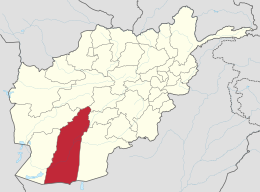Alizai rebellion of 1923
Appearance
| Alizai rebellion of 1923 | |||||||
|---|---|---|---|---|---|---|---|
 A map of modern-day Helmand Province, where the fighting took place. | |||||||
| |||||||
| Belligerents | |||||||
| Emirate of Afghanistan | Alizai rebels | ||||||
| Commanders and leaders | |||||||
| Amanullah Khan | Unknown | ||||||
The Alizai rebellion of 1923[5] was a rebellion by the Alizai tribe in the region of Zamindawar, in modern-day Helmand Province of the Emirate of Afghanistan, which took place in 1923.[6] The causes laid in opposition to the reforms of Amanullah Khan,[6] namely in regards to conscription and taxation.[1] The rebellion lasted 6 months, largely because none of the conscripted battalions in the south were willing to fight the Alizai.[6] Ultimately, the rebellion was defeated with troops from Herat, who executed rebel leaders and deported groups of Zamindawaris to Afghan Turkestan.[6]
See also
[edit]- Khost rebellion (1924–1925), uprising in Afghanistan that begun in the subsequent year
Notes
[edit]- ^ According to Survey of International Affairs, the rebellion started in summer 1923,[1] and according to An Intimate War: An Oral History of the Helmand Conflict, 1978–2012, the rebellion lasted 6 months. Since all sources agree that the rebellion took place in 1923, the earliest possible start date is 22 June (the date of summer solstice in Afghanistan in 1923[2]), while last possible start date is 1 July[3] (6 months after any later date would put the end date in 1924[4]).
References
[edit]- ^ a b Toynbee, Arnold; Toynbee, Veronica Boulter (1925). Survey of International Affairs. H. Milford, Oxford University Press. p. 566.
- ^ "Seasons in Kabul – First Day of Spring Season".
- ^ "Calculate Duration Between Two Dates – Results".
- ^ "Calculate Duration Between Two Dates – Results".
- ^ Beautement, Mark (2016). "Peace in whose time? Ripeness and local negotiated agreements" (PDF). p. 106.
- ^ a b c d Martin, Mike (2014-07-01). An Intimate War: An Oral History of the Helmand Conflict, 1978–2012. Oxford University Press. pp. 26, 27. ISBN 9780190237912.
